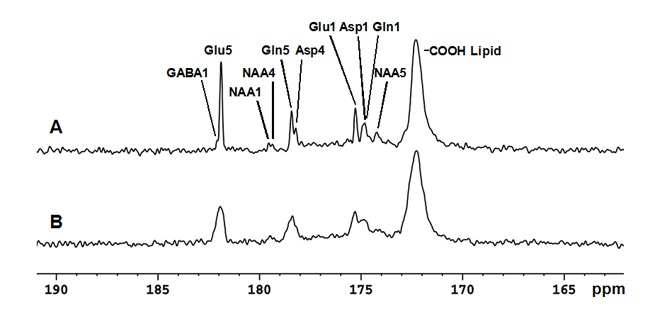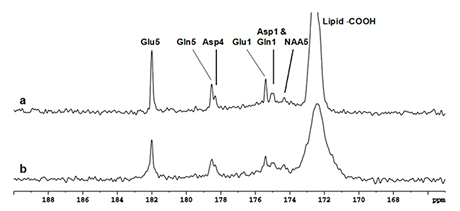Carbon-13 Spectroscopy of Human Brain
A proton decoupled 13C spectroscopy method using intravenous infusion of [2-13C]glucose is being developed on a GE 3.0T clinical scanner. Using this approach we detected the 13C signal of glutamate, glutamine, γ-aminobutyric acid (GABA), aspartate, and N-acetylaspartate (NAA) from the carboxylic/amide spectral region. The method allows investigators to measure glucose, glutamate and glutamine kinetics associated with glucose metabolism and glutamatergic neurotransmission in human subjects.
The 13C signal is detected by using a surface coil placed against either the occipital lobe or the frontal lobe to achieve optimum signal-to-noise ratio. A proton coil is also utilized to provide head positioning and magnetic field shimming and to perform NOE and proton decoupling during 13C data acquisition. Both half-volume proton surface coil and volume proton birdcage coil are available depending on the application requirements.
Two antecubital veins were cannulated, one for administering [2-13C]glucose solution and the other for withdrawing blood to monitor glucose. A MR-compatible infusion pump was used to infuse [2-13C]glucose solution (99% enrichment, 20% w/w). During glucose infusion, blood samples were withdrawn approximately every 10 minutes to measure blood glucose levels.
Figure 8 in below shows an accumulated 13C spectrum acquired from the occipital lobe with proton decoupling (A) and without proton decoupling (B). A half-volume surface proton coil was used to perform NOE and proton decoupling. Signal-to-noise ratio and spectral resolution are significantly improved with proton decoupling and NOE.

13C spectra acquired using birdcage coil for proton decoupling are shown in Fig. 9 in below where the upper spectrum (Fig. 9a) was obtained from the occipital lobe and the lower spectrum (Fig. 9b) from the frontal lobe of a healthy human volunteer. Because the strong magnetic field inhomogeneity in the frontal lobe region, the 13C linewidth is broader and SNR is lower for the frontal lobe spectrum as compared with the occipital lobe spectrum.

lobe (a) and the frontal lobe (b) with the volume birdcage coil
for proton decoupling.
Reference: : Li S, Zhang Y, Wang S, Ferraris Araneta M, Johnson CS, Xiang Y, Innis R, Shen J: “13C MRS of Occipital and Frontal Lobes at 3 Tesla Using a Volume Coil for Stochastic Proton Decoupling.” NMR in Biomedicine, 23, 977-985 (2010).

